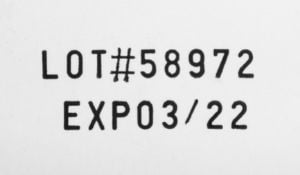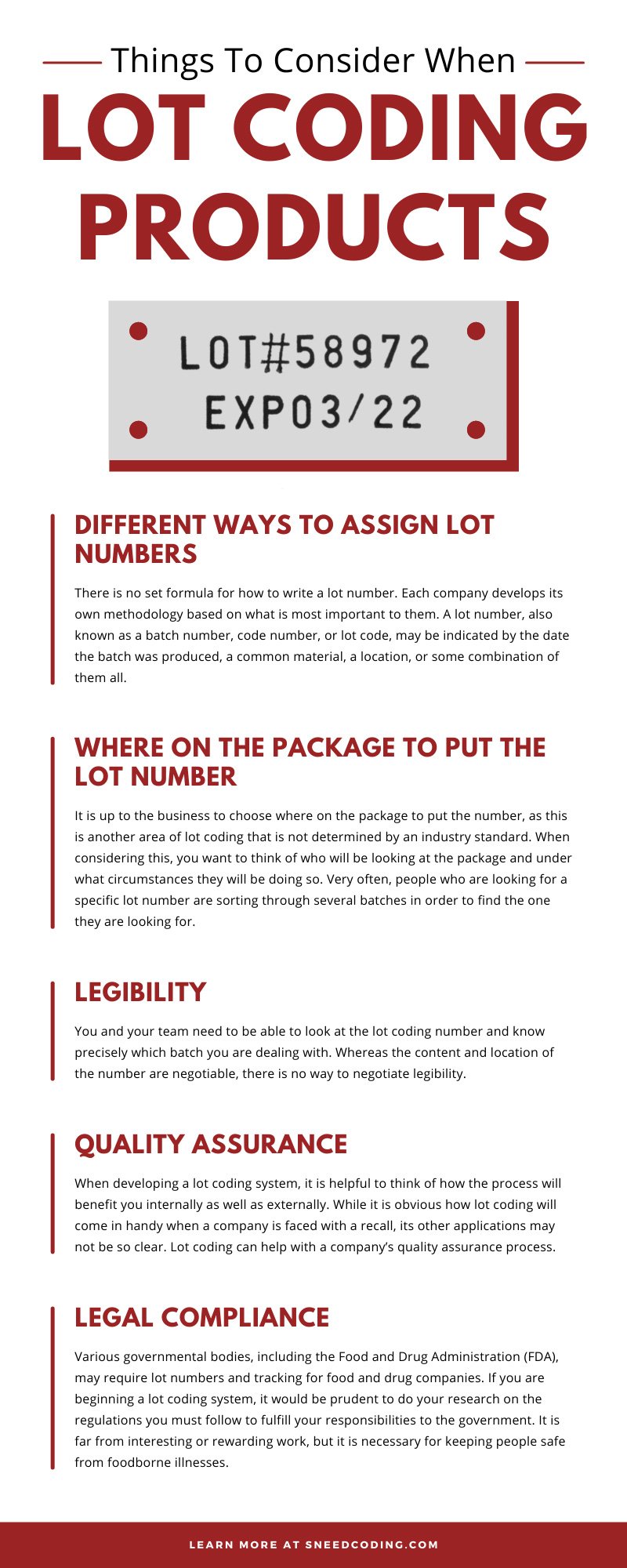
When you are building the many processes that maintain your supply chain, it is important to learn the things to consider when lot coding products. Lot coding is the system by which companies assign numbers to different product batches so they can trace their goods in the event of a recall.
If everything works perfectly, a company can use its lot coding system to identify the batch that needs to be recalled, allowing them to easily find and recall all the affected goods. It might seem easy enough, but imagine dealing with that problem on a scale that stretches across continents. Since it is so vital to get this process right, there are innumerable considerations you must ponder as you develop your own system.
Different Ways To Assign Lot Numbers
There is no set formula for how to write a lot number. Each company develops its own methodology based on what is most important to them. A lot number, also known as a batch number, code number, or lot code, may be indicated by the date the batch was produced, a common material, a location, or some combination of them all.
It is important to consider the best course of action for assigning your lot coding numbers. Think of what you will intuitively understand and what you can easily explain to others. More than anything, you want a system that avoids unnecessary complexities.
Where on the Package To Put the Lot Number
It is up to the business to choose where on the package to put the number, as this is another area of lot coding that is not determined by an industry standard. When considering this, you want to think of who will be looking at the package and under what circumstances they will be doing so.
Very often, people who are looking for a specific lot number are sorting through several batches in order to find the one they are looking for. To make life easier for those people, you should consider putting the number in a prominent place on the packaging before you turn on the marking and coding equipment.
Legibility
You and your team need to be able to look at the lot coding number and know precisely which batch you are dealing with. Whereas the content and location of the number are negotiable, there is no way to negotiate legibility.
It will always be in your best interest to put a clear, legible lot number on your products. Doing so will take the strain off factory workers that need to move the packaging along as well as any people in the future who may need to look it over. No one wants to be in the position where their product gets recalled, especially if they cannot accurately locate the packages because the print is too faded or smudged.
Quality Assurance
When developing a lot coding system, it is helpful to think of how the process will benefit you internally as well as externally. While it is obvious how lot coding will come in handy when a company is faced with a recall, its other applications may not be so clear. Lot coding can help with a company’s quality assurance process.
When you randomly test products from different batches, you can locate the lot numbers of defective items. You can then use this information to target the units you need to pull from shelves. The organizing principles behind lot coding make it an indispensable tool for quality assurance. As you prepare your lot coding system, think of how you can scale your quality assurance alongside it.
Legal Compliance
Various governmental bodies, including the Food and Drug Administration (FDA), may require lot numbers and tracking for food and drug companies. If you are beginning a lot coding system, it would be prudent to do your research on the regulations you must follow to fulfill your responsibilities to the government. It is far from interesting or rewarding work, but it is necessary for keeping people safe from foodborne illnesses.
Official Certifications
There are a great many professional certifications that a business can get to prove its legitimacy. Especially when it comes to supply chain, where so much of the industry depends on trust in other people’s competency, it can be helpful to get official certifications.
The International Organization for Standardization (ISO) offers such a certificate for lot coding. However, businesses that want to go the extra mile should do some research on similar certifications that are specific to their industry. With a few of these certifications under your belt, you can go about your work with confidence that you have the seal of approval from opinions that truly make a difference.
Keep Products With the Same Lot Number Together
In the event of a recall, it would be helpful to keep all the affected products that have yet to leave the warehouse in one location. It is easier to locate items and address problems if you know where you have stored everything. Also, keeping batches together will discourage workers from mixing the products or placing them where they do not belong.
Barcode Scanners
You do not necessarily need a barcode scanner when you develop your lot coding system. Some people can track the batches just by looking at the numbers displayed on the products. However, it is a good idea to at least consider barcode scanners, as they eliminate much of the human error inherent in eye-balling numbers.
Inventory Management Software
Similar to barcode scanners, you do not necessarily need inventory management software, but it could be a good idea to consider it. You can integrate the barcode scanners and other tools with efficient, up-to-date software to help you stay current on the numbers and your overall inventory. The whole process could be a lot easier if you find software with a field for lot numbers.
Now that you know the things to consider when lot coding products, you can put these thoughts to use in your own business. Use this article as a resource, as it will provide you with many of the questions that millions of business owners have faced before you. Although the questions are easy to come by, uncovering the answers can be far more difficult.
The key is just to take it one step at a time. Think about your needs now, your potential needs in the future, your obstacles, and your advantages. With that information, you should be able to put together an excellent lot coding system.



